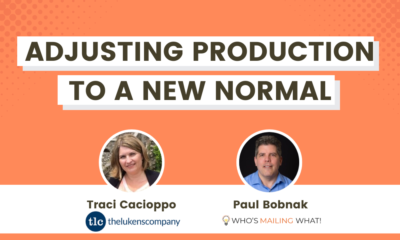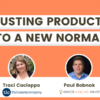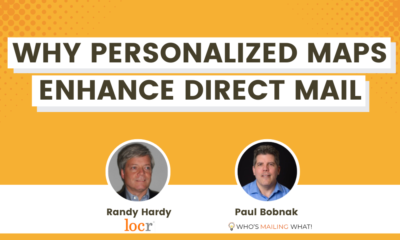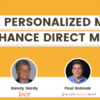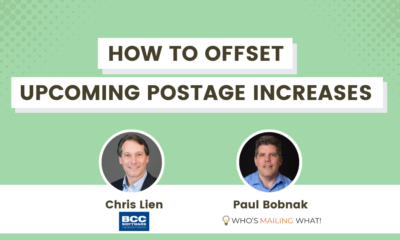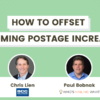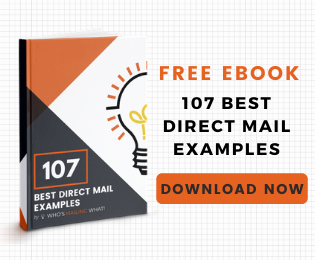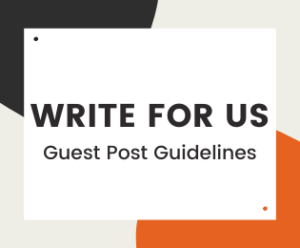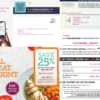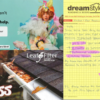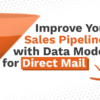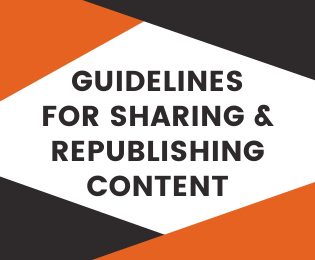MEET THE MAILERS
Meet the Mailers: Creating a Direct Mail Experience
In this episode, we talked with Westamerica Communications about tips for financial, automotive, and nonprofit direct mail.
In this episode, I talked with Mark DeBellis. He is the President, Financial Services Team and Corporate Vice President, Marketing & Business Development for Westamerica Communications.
Located in Lake Forest, CA, Westamerica is a marketing solutions provider, dedicated to innovation, integrity, and delivering results.
We talked about how the company’s continuing evolution beyond printing services is all about helping marketers ask the right questions when planning a direct mail campaign and creating a customer experience:
What [and] why are we gonna do direct mail? What are we trying to accomplish?
 Mark DeBellisDivision President
Mark DeBellisDivision President
Westamerica Communications
Among the many topics we covered:
- Mark’s background and current role at Westamerica
- The services the company offers
- Tips for financial, automotive, and nonprofit direct mail
- Direct mail’s value proposition
- Trends in direct mail marketing
Here are some questions and answers (edited for clarity and space):
- What other strengths are there for companies to be vertically integrated?
All of those things matter and they matter even more today. If we can streamline our process in such a way that we’re able to add value not only in turnaround, but also in overall cost. Because those have real implications in the marketplace. [I]f you have to wait to respond or you’re losing days or hours by a process that’s not reacting quickly enough – that costs money for our customers, so we put a high value on that. [S]o we’re always looking for ways to be more efficient.
And today, you probably have heard that there’s been a big issue with the paper. Coming out of this pandemic and it’s not only paper, lots of products. We all have been impacted by the supply chain challenges … Now, most printing companies had what was, you’ve heard the term just-in-time inventory. Have their projects lined up, and the next day the paper companies would deliver the inventory necessary for that job.
So they took all the risk and all the responsibility for inventory. Well, that has gone away. That’s not happening right now. The paper companies have said “We don’t have the supply to do that”. So what we’ve become in effect is a conduit for the paper itself, but not for the inventory and warehousing.
What that means is a company like Westamerica, which we’ve taken a very proactive role, which frankly is very expensive to actually inventory. We’ve got nearly a million dollars of inventory of paper alone, which we didn’t have to do a year ago. Why do we do that? Because if we don’t do that, we’re not gonna be able to meet the needs of our customers when they need it.
I think as the audience looks at this dynamic and begins to try to compare that with their resources …if you ask those kinds of questions of your provider, make sure that they have the ability to deliver because at the end of the day, it’s really about that … getting that solution to you when you need it, that you can depend on it.
[T]hat’s a question now to add to those interviews. When you start interviewing for a company that can provide these kinds of services, “Hey, what’s your paper supply chain look like, and how have you controlled some of the stockouts and things that happened?”- Let’s talk about financial services marketing. What kind of changes are happening and what do companies need to do to keep up with laws or consumer demand for more security?
Well, that’s really a big issue. We’re all living through a weird time in our existence where information is everywhere. And, you know, seemingly there’s a lot of ways that you can fall into a trap, you know of giving away information or people finding their information. So the financial institutions are the ones that we’ve worked with, and I’ve worked with them for many years now, and I’ve seen this change as they’ve needed to.
They’re stewards of your data, so they have to be very mindful of not only how that data’s used, but who gets access to it. So I wanna let everybody know I need that might be watching this as a consumer: when we get data from our financial customers, the data they send us, first of all, has been scrubbed to make sure that only the data that we absolutely positively need is being sent.
[T]hat’s a responsible relationship because …there’s a lot of information out there, which with the wrong keystroke or the wrong mindset can be sent to a provider. So, you don’t want as a provider any more than what you need to complete the project. So we’ve seen not only that taking place, more awareness at, on the part of the customer side to be keeping that data away from only those who need it. And then on our end as a processor of sorts processing that data, we’ve got multiple security procedures in place. We’re audited every year on our security practices and procedures. We have a very detailed policy. We have protocols we go through. There’s access limitations [on] who can go into certain rooms.And then the other part of that too [is] we immediately wipe the data after we use it. So there’s no reason for us to keep that data around. So even if it’s just names and addresses, we get rid of it. We just don’t want to be in the habit of collecting things because it doesn’t really serve a purpose. Being able to serve a financial institution today does require a lot of approvals and due diligence.
So it’s not unusual for us when we sign on a new client, to go through a process with their department to see all of the things I mention and understand what our protocols are. And our commitment to that continues to grow. [W]e’re continuing to add different levels of security, protocols that are nationally recognized, that type of thing so that we give our customers confidence. [T]he worst thing in the world is to have someone have a data breach.
- What are some ways that automotive marketers can use direct mail to build their brand and also build customer relationships?
We’ve done some work in the automotive space and I’ll talk through that, but you know where direct mail sometimes gets disconnected, are those very large durable goods like autos, appliances, furniture, house/housing, other things. And so the way we’ve used direct mail with auto customers is to be part of the fulfillment process. I mentioned our storefront. And so what can be done in there is that we can receive lists that are updated and uploaded on a regular basis that go to our fulfillment department and we can send out materials.
[I]magine you were on the list for a high-end new model that’s coming out. And so when that kind of piece, and this is actually not it, but it’s just an example of a high quality coffee table type piece that got sent out to each of these potential buyers. And so, you know, like we were talking earlier, this was actually an annual report we did for one of our financial clients. But that kind of … a high-quality, more expensive piece, that would be then sent out … we know that that piece is gonna get opened.It’s not a little postcard: “Thank you for your interest”. It’s an experience that you’re providing for that individual! And that’s the other side of this whole effort in direct mail: you have to also be remembering what’s the experience gonna be when that consumer interacts with your information?
We have to get past creating it because that’s part of it, part of the journey. But the other side is “How are they gonna feel when they get it?” And because they feel it. If they feel what you’ve communicated when they open that and they’ll respond. They may not buy right now, but they will be impacted.
And so that’s part of the direct mail experience. So we wanna think of it not just as a set of printed materials, but the experience that they’re going to go through.
- Well, does that kind of drive for creating experience, how does that apply to nonprofits and basically how can nonprofits best use their direct mail to engage contributors or members?
So, great question. And we are fortunate that we work with a number of nonprofits and very large ones that are national in scope and then some very local ones. And the thing about nonprofit mailing that you are always mindful of is because of the nature of their business and their mission, they always have to be asking for a donation.
It’s just part of the protocol. And it’s not unexpected because typically the smaller nonprofits … they live and die by those donations. Larger ones get grants and things, but the donation is their lifeblood. So it’s really like their order … they’re not selling you a product per se, they’re explaining a service and asking you to be part of that mission, essentially.
[W]hat we try to do is help them create the best combination of offers or options for the recipients. So if somebody, you know, if you genericize that as a nonprofit, and let’s say you make every coupon 10, 25, 50, and a 100, let’s say. Well, if the guy last year gave you 500, [and] you’re not giving the option of putting 500 in again, he might just drop down to a 100. So we try to encourage them to ”let’s look at what history has told us and apply the right options for the right person.” So somebody might be, that’s all they can offer or give at the $25 level and others can add a couple zeros to it.So, that’s one of the strategic things when you think about nonprofits … you wanna help them, because that helps them maximize the investment …. They get some breaks, as you know, with postage, fortunately, but it’s still expensive and we want to make sure that it’s designed well.
That’s another thing. I think that sometimes gets lost a little bit in the nonprofit world in that there’s a belief sometimes that if it looks like it’s nicely designed, that it is expensive. And, you know, we are in a world today where everything’s in color, you know, 4K TV, and so on.
[W]e just have to meet people where they are, make sure that we have a pleasant experience when they’re interacting with your materials. It’s easy to read. It’s accomplishing what you want it to accomplish as far as the conversation goes. And so I would urge people to just be mindful of that tendency to want to go on the cheap and just do it. Do an adequate job at least. And one of our other nonprofits actually kind of on the opposite end of the scale is Wyland. Wyland the artist, if you know … he’s the artist that focuses on ocean and sea. And we work with his foundation.So, it’s not over the top. But it’s nice quality and his galleries and he has his events and all the proceeds that he generates go to his Save the Ocean Initiative. And we’ve been a long-time partner with him. I’m very happy about what he does. We’re in Southern California and his office is just, you know, 15, 20 minutes away from us. [I]it’s been a wonderful relationship.
We are continuing to add more nonprofit customers. They desperately need to have a voice and to get out in front of these potential donors. And because there’s a lot of good work being done in the nonprofit space, and that’s their lifeblood, honestly, is really direct mail.
And I would encourage everyone to look at each channel and do their best to evaluate the return that you’re receiving, from each channel because you’ve gotta use ’em all effectively. And I think there’s been a huge reliance on digital for a lot of reasons. Direct mail does provide different benefits. So just keep that in mind as you start exploring those things.
- So what would you say is the best value proposition for direct mail today? Why does it still work so well?
You know, here’s what happens sometimes. Someone might say, “Hey, I wanna do a postcard”. Because postcards honestly are probably the least expensive direct mail tool. And they can be effective. No question about that. [W]e do a lot of postcards, but I think what happens sometimes is we let the budget get in the way of the process.
So we said, “Well, I can afford a postcard, so I’m gonna do a postcard.” And I would say, “If you can’t do anything else, then do the postcard.”
But I would start with the why and the what. What [and] why are we gonna do direct mail? What are we trying to accomplish? What’s the right tool?
Because we could start with a simple postcard … let’s say two-sided, or we could use a mailer that might be a deeper experience where it opens and we have more information that may be necessary to explain something, or we could have a letter that is a a different experience.
So yes, it does kind of ratchet up when it comes to the budget, but again, let’s make sure we’re sending it to the right people, getting the highest possible response, and making sure we’re doing the product or the opportunity justice. And so that’s where I’d kind of leave that – I think each one of these options becomes relevant if it’s in the right context.
Here is our conversation. We’ve added timecodes for your convenience.
Thanks very much, Mark, for sharing your story and the informative chat! To learn more about Westamerica, visit their website at www.mywestamerica.com.
Your comments and ideas are very important to us in making your Who’s Mailing What! experience even better for you. Through these engaging talks, we hope you’ll take away practical tips, insights, and personal stories to inspire and build your own success.
If you have any feedback — or are interested in sharing your expertise and viewpoint with our wide and diverse audience on “Meet the Mailers” — please reach out to me. I’d love to hear from you!









